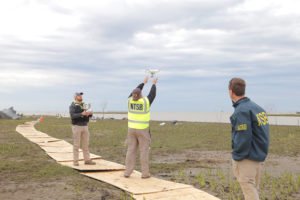The NPRM proposes to modify NTSB’s current authority by eliminating the gross takeoff weight of 300 pounds or greater which is tied to the “substantial damage” clause triggering an investigation. The NPRM instead proposes to link the “substantial damage” clause to all aircraft that hold an airworthiness certificate or approval. The category of UAS that hold an airworthiness certificate or approval is very broad and will continue to expand as the industry evolves. New technologies and construction materials, including light-weight and frangible materials, ensure that small UAS are purposefully built to lessen any impact and damage to the public, other aircraft, or to property. Accordingly, AUVSI advises the NTSB to take into consideration the FAA’s risk-based requirements of aircraft that receive an airworthiness certificate or approval and the extreme low-risk categories that many of these aircraft fall into. For example, the complete elimination of the weight standard may not best the best way to achieve NTSB’s intent. Instead, AUVSI suggest maintaining a maximum takeoff weight tied to the “substantial damage” clause, such as what the Federal Aviation Administration (FAA) defines as the small unmanned aircraft system (sUAS) category, consisting of UAS of less than 55 pounds. AUVSI also suggests refining the proposed language to align with the FAA’s Part 107 Rule (14 CFR 107) accident reporting language. Specifically, we propose the condition to specify that these accident investigations are only undertaken if the cost of repairs exceeds $500 and/or the fair market value of property damage exceeds $500, as is the case in the Accident Reporting clause of §107.9 This will ensure that the NTSB’s authority is targeted in a cost effective manner that yields true benefits to aviation safety.
Furthermore, AUVSI encourages NTSB to clarify that “unmanned aircraft accidents” is not intended to apply to expected or intended damage to unmanned aircraft that are intentionally designed with risk mitigation software and hardware as part of the airworthiness certification. Many UAS that receive an airworthiness certificate or approval are purposefully built to sacrifice the integrity of the craft and are manufactured with frangible materials that break apart on impact and/or absorb collision energy to lessen the impact on persons or things. In another example, in the case of very high winds, a UAS may be instructed to, or may automatically, deploy a parachute to land in a remote area as quickly as possible. Dependent on the terrain, such a landing could cause “substantial” damage to the UAS, however, that damage is expected and accepted as part of the drone’s expected behavior for risk mitigation. These and many other types of risk mitigations are built into UAS that are receiving an airworthiness certification. Therefore, clarification that an accident investigation is not required when the UAS acts as intended as defined by the airworthiness certificate or approval, even if damage is incurred, would be appropriate.

Miriam McNabb is the Editor-in-Chief of DRONELIFE and CEO of JobForDrones, a professional drone services marketplace, and a fascinated observer of the emerging drone industry and the regulatory environment for drones. Miriam has penned over 3,000 articles focused on the commercial drone space and is an international speaker and recognized figure in the industry. Miriam has a degree from the University of Chicago and over 20 years of experience in high tech sales and marketing for new technologies.
For drone industry consulting or writing, Email Miriam.
TWITTER:@spaldingbarker
Subscribe to DroneLife here.
